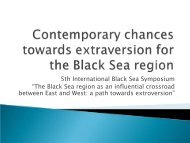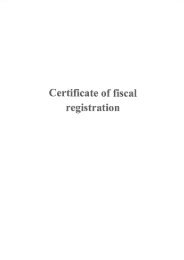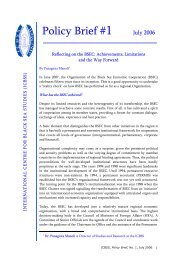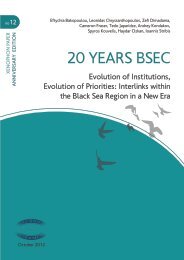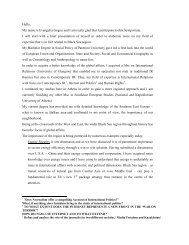Xenophon Paper 2 pdf - ICBSS
Xenophon Paper 2 pdf - ICBSS
Xenophon Paper 2 pdf - ICBSS
Create successful ePaper yourself
Turn your PDF publications into a flip-book with our unique Google optimized e-Paper software.
It is proposed that the ENPI be divided into two ‘windows’. The first will focus on crossborder<br />
cooperation, while the second “will provide more flexible support for wider transnational<br />
cooperation involving actors and beneficiaries from both EU member states<br />
and partner countries”. Although programmes in Window One will be mainly bilateral,<br />
“multilateral programmes may be established in particular over those maritime crossings<br />
where distance and other factors do not allow for efficient bilateral cross-border<br />
cooperation”, with multi-annual programmes to be established for “single borders or<br />
groups of border”. Tentative priority areas in Window Two include environment, energy,<br />
transport and telecommunication networks, public health and the fight against crime.<br />
A significant increase in funding is envisaged under the ENPI, which will become<br />
operational under the EU’s new financial perspective from 2007 onwards. In addition,<br />
the EU intends to open up project financing, so far unavailable, from the European<br />
Investment Bank (EIB) for the ENP partners.<br />
All this goes a long way towards providing a sound material foundation for the future<br />
EU policies and practical activities in the Black Sea region once the appropriate political<br />
decisions are made.<br />
The European Neighbourhood Policy was initiated in spring 2002, focusing initially on<br />
the three ‘New Neighbours’: Ukraine, Moldova and Belarus. 6 The scope of the new<br />
policy has subsequently been expanded in stages to include also the Southern<br />
Mediterranean partners and the three South Caucasus states, increasing the number<br />
of partner countries from three to sixteen. The expansion of the scope of the ENP has<br />
increased the relevance of the Black Sea region to the new policy. Whereas the ENP<br />
initially included only two of the twelve BSEC members, the programme now covers<br />
half of its members. 7<br />
Differentiation is a guiding principle of the European Neighbourhood Policy, with bilateral<br />
Action Plans with the partner countries as its principal instrument. However, differentiation<br />
should be “compatible with a coherent regional approach, especially where further<br />
regional co-operation can bring clear benefits”, and “it is important to foster close<br />
cooperation both across the EU’s external borders and among the neighbours themselves<br />
- especially among those that are geographically close to each other”. 8 For this purpose,<br />
the twenty eight pages ENP Strategy <strong>Paper</strong> includes a three-page section on regional<br />
cooperation, in addition to numerous references to regional and multilateral cooperation<br />
throughout the document. But in spite of the relative prominence of the term ‘regional<br />
6 It was initially known as the ‘New Neighbours Initiative’, changing in 2003 to the ‘Wider Europe Initiative’, and<br />
in 2004 to the current ‘European Neighbourhood Policy’.<br />
7 Originally only Moldova and Ukraine, now also the three South Caucasus states and (partially) Russia.<br />
8 Commission of the European Communities (2004), European Neighbourhood Policy: Strategy <strong>Paper</strong>, COM(2004)<br />
373 final, Brussels, pp. 8 and 20 (further referred to as ENP Strategy <strong>Paper</strong>).<br />
X E N O P H O N P A P E R no 2 61



